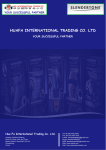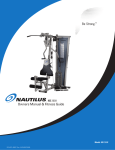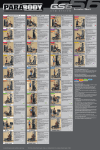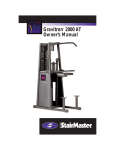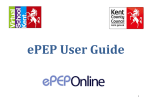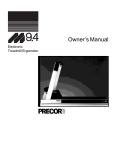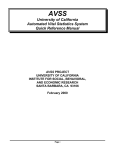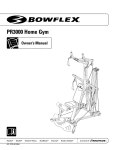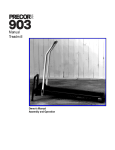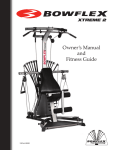Download NS 4000 Owners Manual - Nautilus Support
Transcript
NS4000 Owner’s Manual & Fitness Guide 2 Table of Contents Getting To Know Your Machine ................................. 1 Using Your Machine .................................................2-3 Machine Maintenance ................................................ 3 Defining Your Goals .................................................4-5 The Workouts: The 20 Minute Better Body Workout ..........................6 Advanced General Conditioning ..................................6 Complete Conditioning ...............................................7 Strength Training .........................................................8 Chest Exercises: Chest Press .................................................................10 Incline Chest Press ....................................................10 Chest Fly.....................................................................11 Abdominal Exercises: Seated (resisted) Abdominal Crunch ........................11 Shoulder Exercises: Front Shoulder Raise .................................................12 Rear Delt ....................................................................12 Seated Shoulder Press ................................................13 Lateral Shoulder Raise ...............................................13 Back Exercises: Wide Pulldown ...........................................................14 Reverse Grip Pulldown...............................................14 Seated Low Row..........................................................15 Rear Deltoid Row........................................................15 Single Arm Row ..........................................................16 Upright Row ...............................................................16 Arm Exercises: Triceps Kickback.........................................................17 Triceps Pushdown.......................................................17 Biceps Curl..................................................................18 Leg Exercises: Leg Press .....................................................................18 Leg Extension ............................................................19 Leg Curl .....................................................................19 Standing Hip Extension..............................................20 Calf Extension ...........................................................20 Standing Hip Abduction ............................................21 Standing Hip Adduction ............................................21 WARRANTY INFORMATION What Is Covered Nautilus Fitness Products warrants to the original purchaser of this equipment to be free from defects in materials or workmanship, with the exceptions stated below. This warranty is not transferable or applicable to any person other than the original purchaser. Residential Use Nautilus Strength Equipment The frame and welds of the Nautilus strength equipment are warrantied to the original purchaser for 30 years from date of original purchaser. Upholstery, pulleys, bushings and bearings are warrantied for five years to the original purchaser from date of purchase. Cables, grips, and all other parts are warrantied to the original purchaser for a period of 1 year from date of purchase. Institutional Use Nautilus Strength Equipment In commercial settings such as hotels, schools and hospitals, Nautilus strength equipment is covered by the following warranty. • Frame and welds. . . . . . . . . . . . . . . . . . . . . . . . . . . . . 15yrs. • Upholstery pulleys, bushings/bearings . . . . . . . . . . 1yr. • Cables, grips and all other parts . . . . . . . . . . . . . . . . 90 days. Warranties Do Not Cover • Damage due to use by persons who weigh more than 300 pounds. • Damage due to abuse, misuse, accident or acts of God (such as floods). • Consequential or incidental damages. Some states do not allow the exclusion or limitation of incidental or consequential damages, so the above limitation or exclusion may not apply to you. What We Will Do Nautilus Fitness Products will repair any product that proves to be a defect in materials or workmanship. In the event repair is not possible, Nautilus Fitness Products, at its option, will either replace your product or refund your purchase price. How To Get Service To obtain service for a Nautilus Fitness Product, contact an authorized Nautilus Fitness Retailer. You may also contact a Nautilus company representative at 800-864-1270 to help you locate a dealer in your area. How State Law Applies This warranty gives you specific legal rights, and you may also have other rights which vary from state to state. WARNING! Before beginning any exercise program consult your physician or health care professional. Only he or she can determine the exercise program that is appropriate for your particular age and condition. If you experience any lightheadedness, dizziness, or shortness of breath while exercising, stop the exercise and consult your physician. For Your Safety Please Follow These Instructions • Since reading and understanding all warnings and instructions contained in the owner’s manual is essential to safe operation, you must read and understand this owner’s manual prior to using your machine. • Never use dumbbells or any other means to incrementally increase the machine’s weight resistance, other than those means provided by Nautilus. • Keep your body weight centered on the machine or bench while exercising. • Never allow children on the machine. Teenagers should always have parental supervision in the use of this machine . • Be certain that weight pins are completely inserted prior to exercising. • Never move or adjust the bench while sitting or lying on the bench. Never stand on the bench. • Make sure the weight stack or top plate is never pinned in an elevated position. Do not use the machine if it is found in this position. Call your repair facility or consult your assembly guides if this occurs. • Before exercising, make sure the spring lock seat pin is securely fastened and the bench is firmly in place. • Inspect all cables, belts or chains and their connections prior to every exercising. Do not use the machine if any component is found worn or damaged. • Inspect your machine before each workout. Periodically check all fasteners to make sure none have loosened with use. Tighten if necessary. • Never attempt to exercise with more resistance than you are physically able to handle. Getting To Know Your Machine When you buy any exercise equipment, you need stability. You want durability. But these two qualities alone are not enough. You need equipment that’s designed by people who understand the importance of anatomical correctness during exercise. As a supplier of fitness equipment to health clubs worldwide, the Nautilus name has become synonymous with • Ultimate performance • Optimum results, and • Maximum durability. At Nautilus, our expertise in the science of human performance goes into every piece of equipment we offer. We design our machines to be stable, comfortable and to provide the body support you need to exercise with proper form, while avoiding injury. As you pursue your fitness goals, you trust that the same care and craftsmanship goes into our full line of home gym equipment, too. Nautilus®... Making the world stronger since 1970. THE NAUTILUS NS 4000 WEIGHT MACHINE Dual Pull Down Station Pec Dec Station Press Arm Station Leg Press Low Pulley Station 1 Leg Extension/ Leg Curl Station Using Your Machine Weight Selection and Adjustment To adjust weight, make certain weight stack is not in use or lifted. Simply pull the weight pin from the weight stack and select the desired weight. Insert pin completely and make certain it is locked into place before lifting. In general, always start with lower weights and work up to find the weight most appropriate for your goals and capacity. Dual Pull Down Station This innovative station allows for complete freedom of movement which will more effectively target the muscles. This station also has the ability to perform many of the exercises in this manual using each arm separately. You may find this helpful if an injury prevents the use of both arms. Seat Height Adjustment To adjust the seat, pull the seat pin from the side of the machine. Facing the machine, the adjustment is on the right side, under the seat. This adjustment cannot be done while you are sitting on the seat, so you’ll want to position yourself back on the seat after the adjustment to ensure proper seat alignment. Proper seat alignment ensures exercise efficiency and comfort, while reducing the risk of injury. Pec Dec Arm Adjustment Pop pin adjustment allows proper arm positioning on Pec Dec exercises. Also allows arms to move out of the way for storage. Simply pull pin up and place in proper position. Seat Back Adjustment Proper arm length extension for seated rows, chest presses, rear delts, etc. Completed through using the commercial-grade adjustment. Simply pull the pop pin and place seat back in desired position. Press Arm Adjustment This pop pin adjustment allows proper positioning of all chest exercises, seated rows, and moves the arms out of the way for storage. Simply pop the pin out and move it until you reach a comfortable arm position. As a general rule, never start chest exercises behind your shoulders. 2 Using Your Machine Using Cable Station Hand Grips These handgrips offer a variety of grips detailed below as well as two length adjustments. For the longer length adjustment simply attach the longer of the two D-rings to the cable attachment clip. For the shorter adjustment, attach the shorter D-ring as shown. Regular Grip Grasp the handle and cuff together to form a grip without inserting your hand through the cuff portion. Most of the exercises you perform utilize this grip. Hand Cuff Grip Slip your hand through the cuff portion of the grip so that the foam pad rests on the back of your hand. Then grasp the remainder of the grip that is sitting in your palm.. This method of gripping is great for exercises like front shoulder raises or any exercise where your palm is facing down. Grips manufactured under license agreement with Hands-On Sports & Gym Accessories Inc. Patent # 4756527 Machine Maintenance Daily – Before each use you should inspect your weight machine to ensure that the cables and pulleys are in good condition and operating smoothly. If cable appears to have any damage, including bulging, discoloration or any wires are exposed, DO NOT USE MACHINE. Contact your authorized Nautilus Fitness Dealer to service machine. After each use, wipe machine free of sweat with a clean, dry cloth. Upholstery can be cleaned with a mild detergent or spray cleaner. Weekly – If used often, your machine should be thoroughly cleaned using a clean cloth and an ammonia-based cleaner. Wipe machine down completely and be sure to touch up any scratches with touch-up paint to prevent rusting. Twice Yearly – To keep your machine operating smoothly and looking good for many years to come, you want to clean and lubricate the machine’s Guide Rods. Clean the long chrome rods thoroughly using a clean cloth and ammonia cleaner. Wipe rods completely dry. Spray a generous amount of silicon lubricant on the rods. 3 Defining Your Goals Your body will do what you train it to do. That’s why it’s important to define your goals and focus on those goals. Here are some fitness components that will help you define your goals and choose your fitness program. MUSCLE STRENGTH is the maximum force you can exert against resistance at one time. Your muscle strength comes into play when you pick up a heavy bag of groceries or lift a small child. It is developed when a localized muscle is worked both positively (concentric) and negatively (eccentric) at a resistance great enough to perform only five to eight repetitions of the exercise before the muscle fails. Each set of repetitions is followed by a rest interval that typically runs three times longer than the set. Later, between exercise sessions, the muscle overcompensates for the stress and usually increases in both strength and size. MUSCLE ENDURANCE is the ability to perform repeated contractions. It comes into play when you cross-country ski or work on your feet all day. Endurance training addresses the slow twitch, endurance muscle fibers, which depend on oxygen for energy. To develop muscle endurance, use low resistance and high repetitions — about 15-20 repetitions in each set, three sets to each exercise, working the muscle only to fatigue. MUSCLE POWER is the combination of strength and speed of the muscular contraction. This is often misinterpreted as: a) Being directly associated with certain skill or sport and/or b) Meaning that you must move fast. Load is actually a more important factor than speed when attempting to improve power. When training to achieve muscular power, pick a resistance that fatigues you in the 35 repetition range. When performing these reps, it is more important to think of contracting the muscles faster rather than attempting to move faster. Performing sport simulation exercises usually results in a deterioration of the motor pattern or skill. The biomechanically sound method of improving power in your sport is to train for power using the correct joint movements, as described in this manual. Then practice the skill associated with your sport, learning to apply this newly achieved power. BODY COMPOSITION is the ratio of fat weight (fat) to lean weight (muscles, bones and tissue). As you age, the ratio shifts. The fat weight increases and the lean weight decreases. Training for muscle strength will generally increase muscle size and aerobic conditioning will help burn extra calories. Performing these two forms of exercise, either at different times or together, will create the greatest changes in body fat weight. BALANCED STRENGTH and alignment is the result of equal strength developed in all parts of the body. It comes into play in your standing and sitting posture, and in your ability to perform just about any activity safely and effectively. An over-development of the back will round the shoulders; weak or stretched abdominals can cause lower back pain. You want a balance of muscle strength in front and back. In addition, you need a balance of strength between your middle, lower, and upper body. FLEXIBILITY is the ability of a muscle or group of muscles to move the joint through a full range of motion. Flexibility comes into play when you execute an overhand serve or stretch for the top shelf in the kitchen. It is a cooperative movement of opposite muscle groups. When a muscle contracts, its opposite muscle group must relax for the action to occur. Increased flexibility means an increased range of motion, made possible by this simultaneous contracting and relaxing. Good flexibility is important in protecting the body from injury and can be achieved through the balanced strength training programs included in this manual. CARDIOVASCULAR ENDURANCE is the ability of the heart and lungs to supply oxygen and nutrients to exercising muscles over an extended period of time. It comes into play when you jog a mile or ride a bike. It is a critical component of overall fitness and health. Any exercise program must be supplemented with cardiovascular training. 4 Defining Your Goals Reaching Your Goals To reach your goals you must follow a consistent, well designed program that provides balanced development to all parts of the body and includes both aerobic and strength exercise. Only then will you meet your goals safely and efficiently. The workout routines found in this manual are professionally designed and written to target specific fitness goals. Should you not find one specific program to your liking, you can design your own, based on sound information and the principles found in this manual. Designing Your Own Program You may want to design your own personal program specifically geared to your goals and lifestyle. Designing a program is easy, as long as you follow these guidelines. Understand fitness and its components: Improperly designed programs can be dangerous. Take some time to review this manual as well as other fitness guides. Know your current fitness level: Before you start any fitness program you should consult a physician who will help you determine your current abilities. Identify your goals: Goals are critical to choosing and designing an exercise program that fits and enhances your lifestyle, but so is strategy. It’s important not to rush the process and try to accomplish too much too soon. That will lead to setbacks and discouragement. Instead, set a series of smaller achievable goals. Select complementary exercises: Be sure to pair exercises that address compound joint movements and single joint movements. In addition, select exercises that address complementary muscle groups. Put first things first: During each session, first work those muscle groups that need the most training. 5 Remember your cardiovascular component: Any fitness program must contain a cardiovascular fitness component to be complete. So complement your resistance training with aerobic exercise such as walking, running, or bicycling. Training variables: When designing your own program there are several variables that, when mixed properly, will equal the right fitness formula for you. In order to find the best formula, you must experiment with several combinations of variables. The variables are as follows: • Training Frequency: The number of times you train per week. We recommend daily activity but not daily training of the same muscle group. • Training Intensity: The amount of resistance used during your repetition. • Training Volume: The number of repetitions and sets performed. • Rest intervals: The time you rest between sets and the time you rest between workouts. Once you’ve established a base of fitness, follow these basic principles: • Isolate muscle groups: Focus work on specific muscle groups. • Progressive Loading: The gradual systematic increase of repetitions, resistance and exercise period. The Workouts 20 MINUTE BETTER BODY WORKOUT FREQUENCY: 3 DAYS PER WEEK (M-W-F) TIME: ABOUT 20 MINUTES Start by performing one set of each exercise. Warm up with a light resistance exercise that you can perform easily for 5 -10 reps without fatiguing. Focus on practicing and learning your technique before increasing the resistance. Then move to a more challenging resistance you can perform for no less than 10 reps and no more than 15 reps without your form deteriorating. As you become stronger, you can advance to two sets for each exercise. Complete all sets of each exercise before moving on to the next. Rest 30 to 45 seconds between sets. Move slowly on each rep. Use a pace that will allow you to stop the movement instantly at any point in the rep. Count three seconds up and three seconds down and work to fatigue during each set. Body Part Chest Back Shoulders Arms Legs Trunk Exercise Chest Press Seated Low Rows Standing Lateral Shoulder Raise Standing Biceps Curl Triceps Pushdown Leg Press Leg Curl Calf Extension Leg Extension Abdominal Crunch Sets 1-2 1-2 1-2 1-2 1-2 1-2 1-2 1-2 1-2 1-2 Reps 10-15 10-15 10-15 10-15 10-15 10-15 10-15 10-15 10-15 10-15 ADVANCED GENERAL CONDITIONING FREQUENCY: 4 DAYS PER WEEK (M-T-Th-F) TIME: ABOUT 35-45 MINUTES When you are proficient in performing the exercise techniques of the above routine and are no longer realizing results, or if you become bored, it is time to change your program. You can increase your training with this “split system” routine that works opposing muscle groups on different days. To do this, you’ll increase your resistance when you can perform 12 reps perfectly, and you’ll increase your volume by performing more sets and more exercises. Move slowly on each rep. Use a pace that will allow you to stop the movement instantly at any point in the rep. Count three seconds up and three seconds down and work to fatigue during each set. Day 1 & 3 Body Part Chest Shoulders Arms Legs Day 2 & 4 Body Part Back Shoulders Arms Trunk Exercise Chest Press Chest Fly Seated Shoulder Press Seated Triceps Pushdown Triceps Pushdown Leg Press Leg Extension Leg Curl Calf Extension Sets 1-3 1-3 1-3 1-3 1-3 1-3 1-3 1-3 1-3 Reps 10-12 10-12 10-12 10-12 10-12 10-12 10-12 10-12 10-12 Exercise Seated Lat Rows Wide Pulldowns Standing Lateral Shoulder Raise Standing Biceps Curl Abdominal Crunch Sets 1-3 1-3 1-3 1-3 1-3 Reps 10-12 10-12 10-12 10-12 10-12 6 The Workouts COMPLETE CONDITIONING FREQUENCY: 3 DAYS ON, 1 DAY OFF TIME: ABOUT 45-60 MINUTES Body building requires focused concentration and dedication to training, as well as proper eating habits. Train each muscle group to failure before moving on to the next exercise. Do not neglect any muscle group. If needed, include an aerobic activity to increase your caloric expenditure and help to reduce your body fat levels to achieve a defined muscular look. Rest 30-60 seconds between each set and exercise. Focus on proper form. Tighten the muscle before you move, squeeze the muscle as you move, cramp the muscle at the point of full contraction, and resist the movement as you lower the weight. Move slowly on each rep. Use a pace that will allow you to stop the movement instantly at any point in the rep. Count three seconds up and three seconds down and work to fatigue during each set. DAY 1 Body Part Chest Shoulders DAY 2 Body Part Back Arms DAY 3 Body Part Legs Trunk 7 Exercise Chest Press Chest Fly Incline Chest Press Seated Shoulder Press Seated Low Rows Shoulder Raise Sets 2-4 2-4 2-4 2-4 2-4 2-4 Reps 8-12 8-12 8-12 8-12 8-12 8-12 Exercise Seated Lat Rows Wide Pulldowns Standing Biceps Curl Triceps Pushdown Sets 2-4 2-4 2-4 2-4 Reps 8-12 8-12 8-12 8-12 Exercise Leg Press Leg Extension Standing Hip Extension Leg Curl Calf Extension Abdominal Crunch Sets 2-4 2-4 2-4 1-3 2-4 2-4 Reps 8-12 8-12 8-12 8-12 12-15 8-12 The Workouts STRENGTH TRAINING FREQUENCY: 3 DAYS PER WEEK (M-W-F) TIME: ABOUT 45-60 MINUTES This program is designed to emphasize overall strength development. This is an advanced routine to be used only after you have progressed from the advanced general conditioning routine and only after you have perfected your exercise techniques. Work each set to near exhaustion. If you can perform more than 5 to 8 reps, you should increase your resistance 10 lbs. and decrease your reps to 5. Rest 60 - 120 seconds between each set and exercise. Focus on proper form. Tighten the muscle before you move, squeeze the muscle as you move, cramp the muscle at the point of full contraction, and resist the movement as you lower the weight. Move slowly on each rep. Use a pace that will allow you to stop the movement instantly at any point in the rep. Count two seconds up and four seconds down and work to fatigue during each set. Day 1 Body Part Chest Shoulders Exercise Chest Press Shoulder Press Standing Lateral Raise Shoulder Raise Sets 2-4 2-4 2-4 2-4 Reps 5-8 5-8 5-8 5-8 Day 2 Body Part Back Exercise Low Row Wide Pulldowns Standing Biceps Curl Triceps Extension Standing Triceps Kickback Sets 2-4 2-4 2-4 2-4 2-4 Reps 5-8 5-8 5-8 5-8 5-8 Exercise Leg Press Leg Extension Leg Curl Calf Extension Low Back Extension Abdominal Crunch Sets 2-4 2-4 2-4 2-4 2-4 2-4 Reps 5-8 5-8 5-8 5-8 8-12 5-8 Arms Day 3 Body Part Legs Trunk 8 Chest Exercises CHEST PRESS Muscles worked: This exercise emphasizes the chest muscles (pectoralis major). It also involves the front shoulder muscles (anterior deltoid, a portion of the middle deltoid) and the triceps, which are located on the back of the upper arm. Starting Position: • In the seated position, reach to the side of your body and grasp the handles at chest level. Bend your elbows until your hands are near your chest. Rotate your upper arms away from your torso so that your elbows are pointing outward to each side and your palms are facing forward. • Raise your chest and slightly "pinch" your shoulder blades together. Maintain a very slight, comfortable, arch in your lower back. • Slowly return to the starting position with arms straight to the front at shoulder width and in line with your chest. Keep your chest muscles tightened during the entire motion. Key points: • Limit and control the range of motion so that your elbows only travel slightly below the shoulders if at all. START Motion: • Slowly move your elbows outward, simultaneously bending your arms so that your forearms remain parallel to each other and the hands remain over the elbows throughout the movement. • Stop when your upper arms are approximately straight out to your side (elbows should be about level with your shoulders). FINISH INCLINE CHEST PRESS Muscles worked: This exercise emphasizes the chest muscles (pectoralis major), especially the upper portion. It also involves the front shoulder muscles (anterior deltoid, a portion of the middle deltoid) and the triceps, which are located on the back of the upper arm. Starting position: • In the seated position, grasp the handles, and bend your elbows until your hands are near your chest. Rotate your upper arms away from your torso so that your elbows are pointing outward to each side and your palms are facing down. • Adjust the seat back tilt forward to the third or fourth incline position depending on your comfort level. • Hands are positioned just outside of your upper chest, with palms facing down and wrists straight. • Stop when your upper arms are approximately straight out to the sides (your elbows will be level with your shoulders or very slightly below). Key points: • Limit and control the range of motion so that your elbows travel only slightly behind your shoulders — if at all. • For normal pressing/pushing patterns of movement you may choose to allow the shoulder blades to "float" forward and backward naturally with the arm movement, or for increased pec involvement you may keep the shoulder blades "pinched" together throughout both the upward and downward movements. START Motion: • Slowly move your elbows outward at a 45 degree angle to your body, simultaneously bending your arms so that your forearms remain parallel to each other and the hands remain over the elbows throughout the movement. FINISH 10 Chest Exercises CHEST FLY — Shoulder Horizontal Adduction Muscles Worked: This exercise emphasizes the chest muscles (pectoralis major), also involving the front shoulder muscles (anterior deltoid). Starting Position: • Adjust the seat so that your upper arm is level with the floor. • Keeping your back straight, place your forearms against the roller pads. • Be sure that your upper arms are level with your chest, palms facing forward and wrists straight. • Raise your chest and slightly “pinch” your shoulders together. Maintain a very slight, comfortable, arch in your lower back. Motion: • Slowly move your hands together, maintaining the elbow in a bent position throughout the movement. • Slowly return to the starting position keeping your chest muscles tightened during the entire motion. Key Points: • Maintain a 90 degree angle between the upper arms and the torso throughout the exercise. • Limit and control the range of motion so that your elbows travel only slightly behind your shoulders if at all. START FINISH Abdominal Exercises ABDOMINAL CRUNCH — Spinal Flexion Muscles worked: This exercise emphasizes the abdominal area including the upper and lower front abs (rectus abdominous) and the side abs (obliques). Starting position: • Seat back should be adjusted to the farthest back position. • Grasp the Ab Crunch handles with palms facing together and elbows close together. • Your lower back can start out flat or in a normal arch, knees and hips are bent and your feet are on the support pegs. Key points: • Allow exhalation up and inhalation down, don’t exaggerate it. • Do not lift your head/chin. Your head should follow the rib motion, not lead, allowing you to maintain normal neck posture. • Tighten your abdominals throughout the entire exercise range of motion. Do not let your abs relax until the set is over. • MOVING SLOWLY to eliminate momentum is critical. START Motion: • Tighten your abs and curl only your torso, slowly moving your ribs toward your hips. Move as far as you can without moving the hips or neck. • Slowly reverse the motion returning to the starting position, without relaxing. FINISH 11 Shoulder Exercises REAR DELT Muscles worked: This exercise emphasizes the back of the shoulder muscles (rear deltoid) as well as the posterior rotator cuff. Also works the trapezius and rhomboid muscles in the upper back. Starting position: • Sit on the bench facing the machine, knees bent and feet flat on the floor. • Adjust the range of motion pin so that arms are in the first or second adjustment hole depending on your flexibility. • Adjust the seat back so that the center of your shoulder is aligned with the pivot point of the machine. • Your back should be straight and your chest should be against the seat back pad. • Place the back of your upper arm against the roller pads. Both your upper and lower arms should be flat and level to the floor. Motion: • Moving at the shoulders, move your elbows as far back as possible pinching your shoulder blades together at the end of the movement. • With elbows bent, return slowly to the starting position. Key points: • Do not move your back or hips during exercise. • Do not allow the weights to come to rest during exercise. • Move only at shoulders, your arms should remain bent and level with the floor at all times. START FINISH FRONT SHOULDER RAISE — Shoulder Flexion (elbow stabilized near extension) Muscles worked: This exercise emphasizes the front portion of the shoulder muscles (front deltoids as well as the front part of the middle deltoids). Starting position: • Stand facing away from the machine. • Keep your chest up, abdominals tight and maintain a slight arch in your lower back. • Grasp handles with your palms facing backward and arms straight at your sides. Motion: • Keeping your arms straight, move them forward then upward to shoulder height. • Slowly return the arms beside the torso and repeat. START Key points: • Keep the chest lifted and the abdominals tightened throughout the entire motion and maintain good spinal alignment. • Do not increase the arch in your lower back while lifting your arms. FINISH 12 Shoulder Exercises SEATED SHOULDER PRESS — Shoulder Abduction (and elbow extension) Muscles worked: This exercise emphasizes the front shoulder muscles (anterior deltoid, a portion of the middle deltoid) and the triceps, which are located on the back of the upper arm. Starting position: • In the seated position, grasp the handles, and bend your elbows until your hands are near your chest. Rotate your upper arms away from your torso so that your elbows are pointing outward to each side and your palms are facing down. • Adjust the seat back tilt forward to the fifth or sixth incline position depending on our comfort level • Hands are positioned just outside of your upper chest, with palms facing together and wrists straight. • Stop when your upper arms are approximately straight out to the sides (your elbows will be level with your shoulders or very slightly below). Key points: • Limit and control the range of motion so that your elbows travel only slightly behind your shoulders — if at all. • For normal pressing/pushing patterns of movement you may choose to allow the shoulder blades to "float" forward and backward naturally with the arm movement, or for increased pec involvement you may keep the shoulder blades "pinched" together throughout both the upward and downward movements. START Motion: • Slowly move your elbows outward, simultaneously bending your arms so that your forearms remain parallel to each other and the hands remain over the elbows throughout the movement. FINISH LATERAL SHOULDER RAISE — Shoulder Abduction (and elbow extension) Muscles worked: This exercise emphasizes the side shoulder muscles (middle deltoids), the top muscles of the rotator cuff (supraspinatus) and the upper trapezius muscles. Starting position: • Stand facing perpendicular to the low pulley station, grasp the handle with your farthest hand, palm facing the machine. • Place your opposite hand on your hip • Feet should be spaced shoulder width Motion: • Raise your arm so that it is level with the floor, do not go beyond this range. • Keep your elbow slightly bend during the movement. • Slowly lower your arm to the starting position without relaxing or resting the weight. START Key points: • Do not twist your trunk during this movement. • Do not bend your elbow during the exercise. • If you are unable to reach a full range of motion, lower the weight. FINISH 13 Back Exercises WIDE PULLDOWN — Shoulder Adduction (with elbow flexion) Muscles worked: This exercise emphasizes the latissimus dorsi, teres major and rear deltoid which make up the large pulling muscles of your upper back. It also involves the muscles on the front of your upper arms (the biceps group) which are responsible for bending your elbows. Starting position: • Facing the machine, grasp the handles with palms facing forward. • Position your knees directly under the seatback and sit upright with your arms extended up. NOTE: You may position your hips directly under the pulley but make sure to lean back slightly from the hips (not the waist) • Maintain good spinal alignment, chest lifted, abs tight and maintain a very slight arch in your lower back. Motion: • Initiate the movement by pulling your shoulder blades down and together while simultaneously drawing your elbows downward to the sides, and then inward, toward your trunk. • At the end of the motion your arms should be drawn near your sides, your shoulder blades should be fully depressed toward your hips and your forearms must be in line with the direction of the cables (not rotated forward). • Slowly return to the starting position allowing your arms and shoulder blades to move fully upward, without relaxing the muscles. Key points: • From the side view the forearms should appear to remain in line with the cable. • Do not lose spinal alignment. • Do not lean backward as you pull. • Keep the chest up, especially at the bottom of the movement. • Keep the lats tightened throughout the entire motion. • Do not move your elbows posteriorly on the way down. START FINISH REVERSE GRIP PULLDOWN — Shoulder Extension (with elbow flexion) Muscles worked: This exercise emphasizes the latissimus dorsi, teres major and rear deltoid which make up the large pulling muscles of your upper back. It also involves the muscles on the front of your upper arms (the biceps group) which are responsible for bending your elbows. Starting position: • Facing the machine, grasp the handles with an underhand grip. • Position your knees directly under the seatback and sit upright with your arms extending upward. • Maintain good spinal alignment, chest lifted, abs tight and maintain a very slight arch in your lower back. Motion: • Initiate the movement by pulling your shoulder blades down and together while simultaneously drawing your elbows downward to the front, and then back toward the sides of your body. • At the end of the motion, your arms should be drawn near your sides (although may not be touching your sides), your shoulder blades should be fully depressed toward your hips and your forearms must be upward in line with the direction of the cables (not forward). • Slowly return to the starting position allowing your arms and shoulder blades to move fully upward, without relaxing the muscles. Key points: • Do not lose spinal alignment. • Keep the lats tightened throughout the entire motion. • Do not lean backward as you pull. • Keep the chest up, especially at the bottom of the movement. • You will want to rotate your wrists during the movement so that your palms are facing away at the beginning, and facing up at the finish point. START FINISH 14 Back Exercises SEATED LOW ROW — Shoulder extension (with elbow flexion) Muscles worked: This exercise emphasizes the latissimus dorsi, teres major and rear deltoid muscles which make up the large pulling muscles of your upper back as well as the trapezius and rhomboids. The biceps muscles on the front of the upper arm are also involved in the movement. Starting position: • Sit on the floor facing the machine. • Grasp the hand grips with both hands in a overhand or palms down grip. • Place your heels on the footplate, with your knees bent comfortably. • Sit up straight with your spine in good alignment. Motion: • Initiate the movement by pinching your shoulder blades together while simultaneously drawing your elbows down and backward toward the sides of your body. • Continue moving the arms past the sides of the body. • Slowly return to the starting position, straightening the arm and letting the shoulder blades slide forward without slouching. START Key points: • Try to maintain upright alignment at all times during the movement. • You will want to rotate your wrists during the movement so that your palms are facing away at the beginning, and facing up at the finish point. FINISH REAR DELTOID ROWS/COMPOUND ROW — Shoulder Horizontal Abduction (with elbow flexion) Muscles worked: This exercise emphasizes the back portion of the shoulder muscles (the rear deltoids, as well as the rear portion of the middle deltoids, the posterior rotator cuff, upper lat and teres major) as well as the trapezius and rhomboids. Starting Position: • Sit on the bench facing the machine, knees bent and your feet flat on the floor. • Grasp the upper handles with your palms facing down and arms straight. • Sit up straight with your chest on the seat back and until arms/cables are in front of body at a 90 degree angle to your torso. • Lift your chest and slightly pinch your shoulder blades together. Motion: • Allowing your arms to bend as you go, move your elbows outward and backward keeping a 70-90 degree angle between your upper arms and the sides of your torso. • Move until your elbows are slightly behind your shoulders, then slowly reverse the motion keeping the rear shoulder muscles tightened during the entire motion. Key points: • Maintain a 90 degree angle between your upper arms and the sides of your torso during the exercise. • For normal pulling /rowing patterns of movement you may choose to allow the shoulder blades to "float" forward and backward naturally with the arm movement, or for increased rear deltoid involvement you may keep the shoulder blades "pinched" together throughout both the forward and backward movements. START FINISH 15 Back Exercises SINGLE ARM ROW — Shoulder Extension (with elbow flexion) Muscles worked: This exercise emphasizes the latissimus dorsi, teres major and rear deltoid muscles which make up the large pulling muscles of your back. The biceps muscles on the front of the upper arm are also involved in this exercise. Starting position: • Stand facing the low pulley station, grasp the hand grip in one hand while bracing your other hand on the machine • Your back should be at a 45 degree angle to the ground and knees should be slightly bend. • Keep your shoulders and head up and back arched. Motion: • Pull the handle straight back to your hip making sure not to rotate your hips during the last part of the movement • Slowly return the handle forward but do allow the weight to stretch your shoulder to far forward or cause your back to round. Key points: • Do not lose spinal alignment – keep chest lifted. • Release your shoulder blade at the end of each rep and initiate each new rep by retracting your shoulder blade. • Keep the Lat muscles tightened throughout the entire exercise. START FINISH UPRIGHT ROW — Shoulder Horizontal Abduction (and elbow flexion) Muscles worked: This exercise emphasizes the latissimus dorsi, teres major and rear deltoid muscles which make up the large pulling muscles of your upper back as well as the trapezius and rhomboids. The biceps muscles on the front of the upper arms are also involved in this movement. Starting position: • Stand facing the low pulley station with feet, shoulder width apart. • Grasp the hand grips with your palms facing down, back straight and head up. Key points: • Keep your shoulder blades “pinched” together during the movement. • Make sure your back is straight throughout the exercise. START Motion: • Pull the bar straight upwards keeping in as close to the body as possible. • Elbows should bend outward until the hand grips are just below the chin. FINISH 16 Arm Exercises TRICEPS KICKBACK Muscles worked: This exercise emphasizes the triceps muscles located on the back of the upper arms. Starting position: • Face the machine. Bend forward at the hips (not the waist). Bending one knee slightly, flatten your back by sticking your hips out and lifting your chest. • Grasp the handle. • Keeping your elbow bent, bring your upper arm to your side, parallel to the ground. • Place your other hand on the machine for stability. Key points: • Maintain spinal alignment. • Keep your arm at your side and your wrist straight throughout entire motion. • Tighten the triceps throughout the exercise and control the motion. START Motion: • Straighten elbow while keeping your upper arm completely still. • When arm is completely straight, slowly return to the starting position. FINISH TRICEPS PUSHDOWN — Elbow Extension Muscles worked: This exercise emphasizes the triceps muscles located on the back of the upper arms. These muscles are responsible for straightening your arms and assist in any upper body pushing or pressing motion. Starting position: • Grasp the handles, with your palms down. • Keeping your arms bent, bring your upper arms to your side and maintain. • Lift your chest and tighten your abdominals to stabilize your spine while maintaining a very slight arch in the lower back. Motion: • Keeping your upper arms stationary and your elbows next to the sides of your torso, slowly straighten your arms by arcing downward toward your legs. • Straighten your arms fully. • Controlling the motion, allow your elbows to bend, returning to the starting position without moving your upper arm. Key points: • Keep your upper arms motionless. • Keep wrists straight. • Tighten the triceps throughout the exercise and control the motion on the way up. • Maintain good posture by keeping your chest lifted, abs tight and maintain a very slight arch in your lower back. START FINISH 17 Arm Exercises STANDING BICEPS CURL — Elbow Flexion (in supination) Muscles worked: This exercise emphasizes and develops the biceps muscles, which are located on the front of your upper arms and are primarily responsible for bending your elbows, as well as the brachialis and brachioradialis. Starting position: • Facing the machine. • Bend down and grasp the handles with your palms facing forward. • Stand with your upper arms by your sides (although not "smashed" against them). Lift your chest, tighten your abdominals and maintain a very slight arch in your lower back. Motion: • Curl handles forward, then upward, and then in toward shoulders while keeping your elbows at your sides and your upper arms completely still. • Slowly lower to the starting position by performing the same arcing motion. Note: This exercise may be performed using both arms simultaneously, or by alternating between right and left arm. Key points: • Keep elbows at your sides. • Keep wrists straight. • Keep your trunk muscles tight and maintain a very slight arch in your lower back. START FINISH Leg Exercises LEG PRESS Muscles worked: This exercise works all the major muscle groups in upper leg including the quadriceps which are the muscles on the front of the leg, the gluteus muscles of the buttock and the hamstring muscles on the back of the upper leg. Starting position: • Adjust the seat back so that your leg is bent at a 90-degree angle with your feet on the foot plate. • Place your feet on the foot plate at shoulder width apart with toes pointing straight up. • Back should be straight and hips should be firmly against the back pad. Grasp handles lightly at your side. Motion: • Bending at the knees, slowly extend your legs until legs are straight but knees are not locked out. • Knees should remain in line with the rest of your leg. Do not allow knees to bow in or out. • Slowly bend the knees back to a 90-degree angle and repeat. START Key points: • Keep movement slow and controlled. • Do not allow the weight plates to rest during movement. • Do not bend legs more than 90 degrees or lock them out at the end of the rep. • Feet should remain flat against foot plate and should not move during exercise. FINISH 18 Leg Exercises LEG EXTENSION Muscles worked: This exercise emphasizes the muscles on the front of the upper thigh (quadriceps muscle group) which are responsible for straightening your leg against resistance. This powerful muscle group helps provide stability for the knee joint and is essential for producing power in running, jumping and lifting activities. Starting position: • Sit on the seat facing away from the machine with your knees near the pivot point and the lower roller pads on the front of your shins/ankle. • Position your thighs at hip width pointing your knee caps straight to the front. • Grasp handles below the seat. • Sit up straight with your chest lifted, abs tight and maintain a very slight arch in your lower back. Motion: • Tighten your quads and straighten your legs by moving your feet forward and then upward until your legs are completely straight and your kneecaps are pointing up toward the ceiling (not turned outward). • Then slowly return to the starting position keeping tension in your quads during the entire movement. START Key points: • Use slow controlled motion. Do not "kick" into extension. • Do not let your knees rotate outward during the exercise. Keep your kneecaps pointing up and straight forward. FINISH LEG CURL — Knee stabilized in flexion Muscles worked: This exercise strengthens and develops the muscles of your buttocks area (gluteus maximus). Remember, there is no such thing as spot reduction. This exercise will not remove fat from this area, but it will strengthen and build these muscles. Starting position: • Adjustment level should be in the leg curl position. • Lay face down on cushion. Seat back should be adjusted all the way flat. • Place both ankles under the leg rollers with knees near the pivot point. • Grasp handles to stabilize your upper body. • Keep your spine in good posture, abs tight and maintain a very slight arch in your lower back. Motion: • Initiate the movement by tightening your glutes. • Slowly bend your legs as far as you can, without allowing ANY movement to occur at your waist. • Then slowly return to the starting position. Key points: • Do not “kick”when performing exercise. Move slow and controlled. • Keep your abs tight throughout the entire exercise. START FINISH 19 Leg Exercises STANDING HIP EXTENSION — Knee stabilized in flexion Muscles worked: This exercise strengthens and develops the muscles of your buttocks area (gluteus maximus). Remember, there is no such thing as spot reduction. This exercise will not remove fat from this area, but it will strengthen and build these muscles. Starting position: • Facing the machine. • Secure the cuff around the foot. • Bend over 30 - 45 degrees from your hips (not your waist) and very slightly bend the knee of your support leg. • Keep your spine in good posture, with your chest lifted, abs tight and maintain a very slight arch in your lower back. Key points: • Make sure all of your motion occurs at your hip, NOT your waist or low back. • Keep your abs tight throughout the entire exercise. • Maintain exactly the same bend in the knee of your moving leg throughout the entire exercise. START Motion: • Initiate the movement by tightening your glutes. Extend your hip by moving your entire leg backward. • Slowly move your leg as far as you can, without allowing ANY movement to occur at your waist. • Then slowly return to the starting position. FINISH CALF EXTENSION — Ankle Plantarflexion (knee stabilized in slight flexion) Muscles worked: This exercise is great for emphasizing the muscles of your lower leg or calf (gastrocnemius and soleus), which are responsible for raising and lowering your heels at the ankle joint. Strength and power in these muscles are essential for all sports and daily activities. Key points: • Do not allow foot plate to fall back quickly. • Do not change your hip or knee position, ONLY ankle motion should be allowed. START Starting position: • Seated in leg press station. • Feet should be at shoulder width apart with the balls of your feet just below the foot plate. • Legs should be straight but knees not locked. Motion: • Bending only at the ankles, allow the foot plate to come back to a comfortable stretch position on the calf muscles. • Extend your toes as far as possible as if standing on your toes to reach for something. • Slowly return to the starting position always maintaining proper posture. 20 FINISH Leg Exercises STANDING HIP ABDUCTION Muscles worked: This exercise will not burn off fat from your hips or outer thigh! There is no exercise that will burn fat from a specific area. This exercise will, however, strengthen the muscles on the sides of your hips (gluteus medius), especially on the standing/support side. Use light resistance and controlled range of motion on this exercise. You may also think of this exercise as a tool for challenging your ability to stabilize your hip on the supportive leg. Starting position: • Stand perpendicular to the low pulley station, attach the ankle strap to the ankle furthest from the machine (outside leg). • Stand up straight, lift your chest, tighten your abs and maintain a very slight arch in your lower back. • Adjust your position so that there is some resistance in the cables. • In the beginning, you may hold on to the machine for stability. Motion: • Slowly move the attached leg outward to the side away from the pulley (30-45 degrees), keeping your hips and spine perfectly still. • Keep you abs tight throughout the exercise. Key points: • Do not use this exercise for losing fat from your hips. It will not make your hips smaller. Use it to develop hip strength and stability. • Use a very small range of motion. More is not better. • Keep your spine straight and your hips level. Try not to raise your hips when raising your leg to the side START FINISH STANDING HIP ADDUCTION Muscles worked: This exercise will not burn off fat from your inner thighs or make them smaller! There is no exercise that will burn fat from a specific area. This exercise will, however, strengthen the muscles on the insides of your thighs (adductor muscle groups). It also works the muscles on the outside of your hip (gluteus medius) on the side that you are standing on. Use very light resistance and small range of motion on this exercise. Think of this exercise as a tool for challenging your ability to stabilize your hip and stand on one leg. Motion: • Keeping your hips and spine perfectly still, slowly move your attached leg toward the center/midline, away from the pulley. • Slowly control the leg back toward the pulley, returning to the starting position. Key points: • Do not use this exercise for losing fat from your thighs. It will not make your thighs smaller. Use it to develop hip strength and stability. • Keeping your hips and spine perfectly still. • Do not bend at knee. START Starting position: • Stand perpendicular to the low pulley station • Attach ankle strap to the ankle nearest the machine. • Adjust your position away from the machine so that tension is created. • Stand straight, lift your chest, tighten your abs and maintain a very slight arch in your lower back. FINISH 21
























